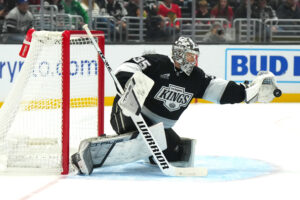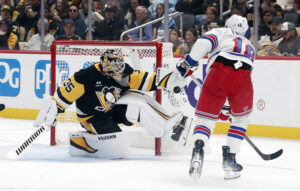The Vancouver Canucks Best by Sweater Number series is getting annoying. Seriously, two of the most annoying players in Canucks history are in today’s list, and deservedly so. Here’s the previous entry.
Vancouver Canucks Best by Number: 10-14
14 – Alexandre Burrows
Well, yeah. This was pretty much a given, wasn’t it? Alexandre Burrows was not just a legendary pest, but also proof positive that playing with top-end talent is a skill in itself.
The undrafted Burrows worked for every inch of his career. He finished his Quebec Major Junior League career a distant third in team scoring as an overager. He led the Shawinigan Cataractes in playoff points with 20 in 12 games, but that wasn’t enough to get the attention of NHL teams. So the next year, he went looking for work and caught on with the Greenville Grrrowl of the ECHL. Later that season, he transferred on to Baton Rouge.
His first pro year gave him a scoring line of 13 goals, 32 points, and 265 penalty minutes in 66 games. He may not have been the most skilled guy on the team, but he was enthusiastic! Neither team re-signed him, though, so the next year he picked up a spot with the Columbia Inferno. Actually playing hockey this time, he scored 29 goals and 73 points in 64 games. He still had 194 penalty minutes, just to keep things interesting.
His play caught the eye of the AHL team that was Columbia’s parent, the Manitoba Moose. The points were nice, but the will to do anything necessary is what got him moved up. He was signed to an AHL contract and learned to control his game and how to pick his spots. He impressed Manitoba’s parent club enough to get a two-way deal in the 2005-06 season.
Better and Better
Burrows was called up to the Canucks in January of ’06 and never looked back. His rookie season was just 43 games long, but it was a lively one. He scored seven goals (including a hat trick) for 12 points and 61 penalty minutes. Perhaps ironically, the team decided to use him as a defensive forward. He was eating up short-handed time and facing skilled players, forming an effective duo with centre Ryan Kesler.
Kesler was developing his form as an eventually Selke Trophy-winning centre, and he and Burrows were a formidable match. But in 2008-09, Vancouver hit a record-setting, eight-game home winless streak. In the spirit of trying anything to get out of a rut, Burrows was joined up with Daniel Sedin and Henrik Sedin. Vancouver won that game and promptly set another record with ten straight home wins.
If he had remained a defensive specialist, there would still be a very good argument to make for his being the Canucks best at number 14.
Much can be made of the Sedins helping Burrows find his scoring touch in the NHL. Burrows had scored 13 goals and 25 points in the 53 games leading up to February 12. In the last 29, he scored 15 and had 26 points. Obviously he wasn’t hitting near point-per-game numbers if his primary concern was stopping opponents.
The Sedin Influence
Between 2008-09 and 2011-12, Burrows played 316 games and scored 117 goals, 218 points, and 438 minutes in penalties. And in that time, the Sedins each passed 100 points in a season, won the Hart, the Pearson, two Art Ross Trophies, and were named to the All-Star Game four times. The amount Burrows benefited from playing with them was reciprocated.
By the time he left the Canucks, Burrows had played 822 games with 193 goals and 384 points.
13 – Mats Sundin
There are, perhaps unsurprisingly, few players who chose number 13. Professional athletes, people whose careers can end in an unlucky instant, tend to be a bit superstitious. Even so, there were two clear choices here. We didn’t go with either.
Artem Chubarov played his entire five-season NHL career with Vancouver, moving between there and the AHL. He eventually played 228 NHL games, scoring 25 goals and 58 points. Solid enough numbers for a young guy on the periphery. There are a few players we’ve picked as the Canucks best at each number with those totals or something like them.
Then there’s Lars Lindgren, a defenceman from their earlier days. He was a formidable player, patrolling the Canucks blue line for parts of six seasons. Moreover, he scored 23 goals and 122 points in 335 games. He was also part of their shocking 1982 Stanley Cup Final run, which has got to count for something.
Toronto Maple Leafs legend Mats Sundin finishing his NHL career by taking a flyer on Vancouver, though is our selection. That was a stunt too funny, and for Canucks fans, anyway, to pass up. He was still a good player at 37 years old, even if it took him a while to get going. In his half-season with the Canucks, he scored nine goals and 28 points in 41 games. Still good enough for ninth on the team.
12 – Stan Smyl
Another “automatic in” at number 12. What can you say about a 5’8″ player who played nearly 900 NHL games? Stan Smyl had his number retired in Vancouver for a reason. He played one year of junior in Bellingham, three Central Hockey League games in Dallas, and the rest of his career in British Columbia.
As for his time with the Canucks, “Steamer” has been with the team in one capacity or another for over 45 years. He is currently a public and business ambassador, code for “Do you want to keep meeting fans?” Before then, he was an affiliate coach in the IHL and AHL, was a Canucks assistant coach under four different head coaches, was a director of scouting in various forms, a director of player development, and, of course, a player.
As a player, Smyl led the Canucks in scoring twice and was voted Team MVP by the fans three times. He’s currently fifth all-time in career points (673) and fifth in games played (896). The archetype for the kind of player fans in Vancouver love to watch.
Canucks Best and Number 11 – Wayne Maki
More Canucks fans should come to know Wayne Maki and his history. While he was eligible in the first NHL amateur draft in 1963, Maki was passed over. That’s not a shock, though, as only 21 players were selected in that first year. Different times!
Maki took the longer route to professional hockey, signing on with the Central Hockey League’s St. Louis Braves. They were an affiliate of the Chicago Black Hawks, the team his older brother Chico Maki already played for. They got to play one season together in the NHL, but expansion was coming.
Chico was the more talented of the two, and Wayne was left unprotected, and the St. Louis Blues scooped him up in 1969’s intraleague draft. He didn’t stay there long, spending most of the season with their AHL club in Buffalo.
Oh, and trying not to serve jail time for a pre-season altercation with Ted Green. That set a new standard, as it was the first time NHL players had been charged for an on-ice fight. Maki avoided jail, but he was suspended for 30 days.
New Home, New Start
Maki was acquired by the Canucks in the 1970 expansion draft, and he took the opportunity. He finished as the team’s second-highest scorer in their inaugural season, with 25 goals and 63 points in 78 games. They weren’t the worst team in the league, and Maki had the chance to score.
The 1971-72 season didn’t go as well, with the Canucks finishing dead last in the league. Maki did fine, though, scoring 22 goals and 47 points, fourth on the team. His third season in Vancouver, his sixth in the league, would be his last.
The team was off to a rocky start, but even with that Maki was noticeable. He wasn’t playing in his usual, feisty style or getting the results fans expected. In December of 1972, he was diagnosed with brain cancer.
Maki left the team immediately. The next season, Chris Oddleifson wore number 11 when he came to the Canucks in a mid-season trade. But as Maki’s diagnosis turned for the worse, Oddleifson switched to 14 until he retired seven seasons later.
Wayne Maki died on May 12, 1974, at just 29 years old.
Canucks Best by Number Coming Up!
You probably noticed the weird numbering we have going on in these entries. Well, first off: welcome to Canucks fandom. Expect the oddness. Revel in the stuff, because it’s everywhere here.
Second, the Number 10 is… complicated. We’re gonna need some room for it. See you then!
Main Photo: Bob Frid – USA TODAY Sports






